-
Out of stock
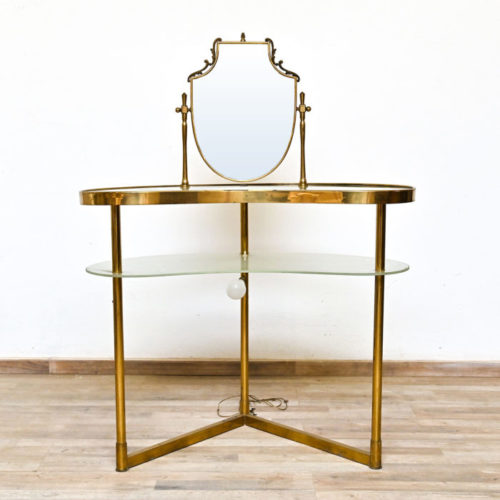 Brass-plated iron bedroom toilet from the 1950s, with lighting on the lower level. The two floors are bean-shaped. Period: 1950s Measurements: H 120 x W 91 x D 49 cm
Brass-plated iron bedroom toilet from the 1950s, with lighting on the lower level. The two floors are bean-shaped. Period: 1950s Measurements: H 120 x W 91 x D 49 cm -
Out of stock
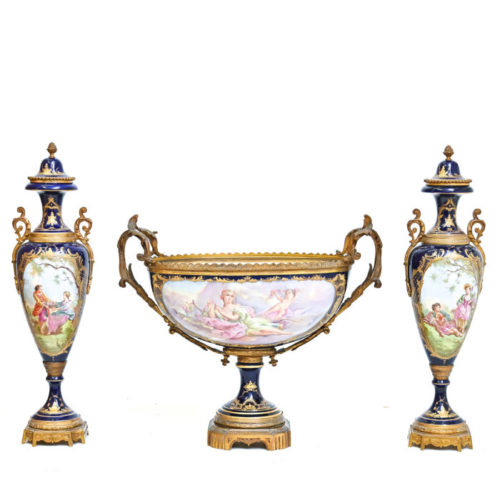 Triptych, bowl and vases Sevres, second half of the 19th century. The triptych is made of painted and gilded cobalt blue ceramic, with gilded bronze applications, in patina. It can be revived and given its original shine. Period: Second half of the 19th century Measurements: Vases H 54,5 x W 14,5 x D 13,5 cm / Cup H 41,5 x W 47,5 x D 25 cm
Triptych, bowl and vases Sevres, second half of the 19th century. The triptych is made of painted and gilded cobalt blue ceramic, with gilded bronze applications, in patina. It can be revived and given its original shine. Period: Second half of the 19th century Measurements: Vases H 54,5 x W 14,5 x D 13,5 cm / Cup H 41,5 x W 47,5 x D 25 cm -
Out of stock
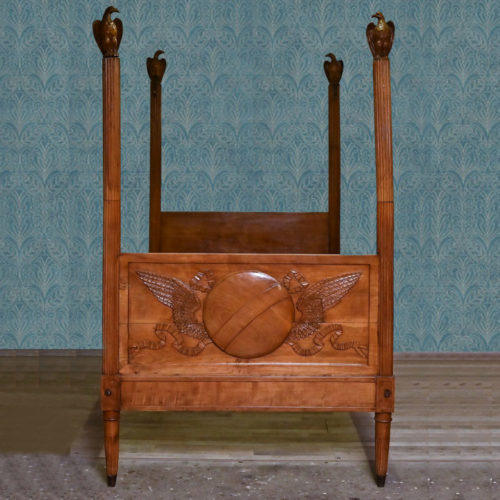 Empire canopy bed in walnut, of French origin. The bed dates from the early 19th century and has columnar uprights and carved eagles. In excellent condition, missing the iron crossbeam, bedstead and mattress. Period: Early 19th century Measurements: H 218 x W 210 x D 130 cm
Empire canopy bed in walnut, of French origin. The bed dates from the early 19th century and has columnar uprights and carved eagles. In excellent condition, missing the iron crossbeam, bedstead and mattress. Period: Early 19th century Measurements: H 218 x W 210 x D 130 cm -
Out of stock
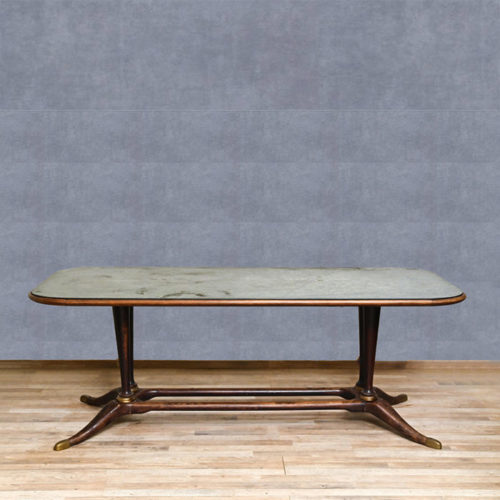 1940s table, of Italian production, with green marble top, excellent structural condition, to be resumed in the finish. Period: 1940s Measurements: H 79 x W 197 x D 90 cm
1940s table, of Italian production, with green marble top, excellent structural condition, to be resumed in the finish. Period: 1940s Measurements: H 79 x W 197 x D 90 cm -
Out of stock
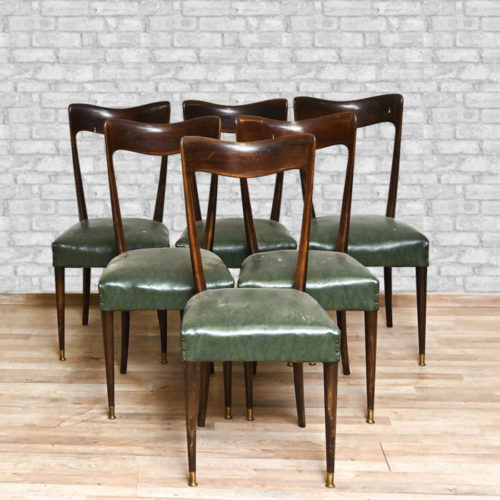 Group of six 40s chairs, made in Italy, with seat in green sky. In excellent structural condition, they are to be resumed in the finish. Period: 1940s Measurements: H 104 x W 45 x D 45 / H Seat 49 cm
Group of six 40s chairs, made in Italy, with seat in green sky. In excellent structural condition, they are to be resumed in the finish. Period: 1940s Measurements: H 104 x W 45 x D 45 / H Seat 49 cm -
Out of stock
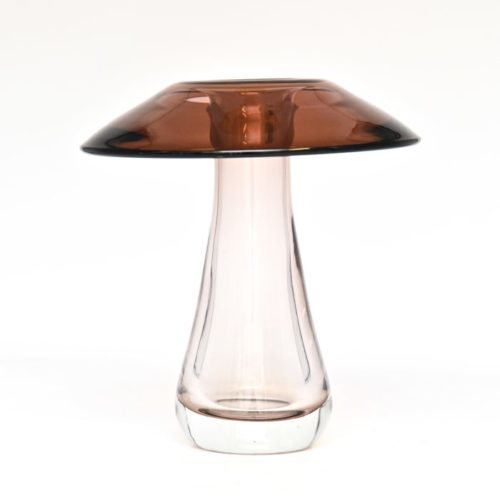 Crystal vase by Antonio Imperatore from the 1980s. This vase was handcrafted in Murano, Italy, by Cristallerie Antonio Imperatore around 1980. It features a clear cylindrical body that gently widens towards its base which represents the "stem" of the mushroom, with a domed upper part in translucent smoked amber glass with a circular hole in the center. In excellent condition. Period: 1980s Measurements: H 28 x Ø 27 cm
Crystal vase by Antonio Imperatore from the 1980s. This vase was handcrafted in Murano, Italy, by Cristallerie Antonio Imperatore around 1980. It features a clear cylindrical body that gently widens towards its base which represents the "stem" of the mushroom, with a domed upper part in translucent smoked amber glass with a circular hole in the center. In excellent condition. Period: 1980s Measurements: H 28 x Ø 27 cm -
Out of stock
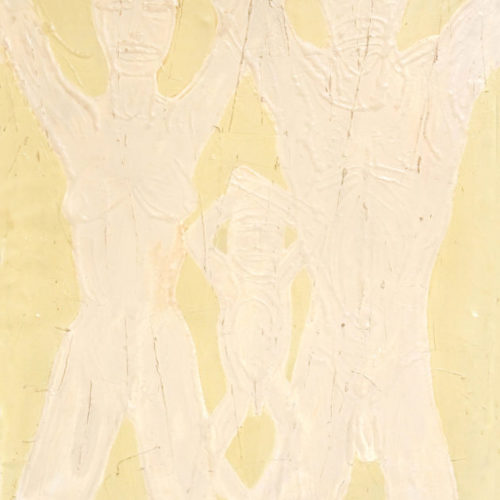 "Primitive family" Oil on canvas by Nik Spatari. Signed on the top right and written on the back "Nik Sparati, Via Solferino 11 Milano". Painting from 1970, taken from the painting exhibited at the 64th Salotto exhibition in 1969. Period: 1970 Measurements: In frame H 124 x W 112 x D 2 / Canvas H 119.5 x W 109 cm
"Primitive family" Oil on canvas by Nik Spatari. Signed on the top right and written on the back "Nik Sparati, Via Solferino 11 Milano". Painting from 1970, taken from the painting exhibited at the 64th Salotto exhibition in 1969. Period: 1970 Measurements: In frame H 124 x W 112 x D 2 / Canvas H 119.5 x W 109 cm -
Out of stock
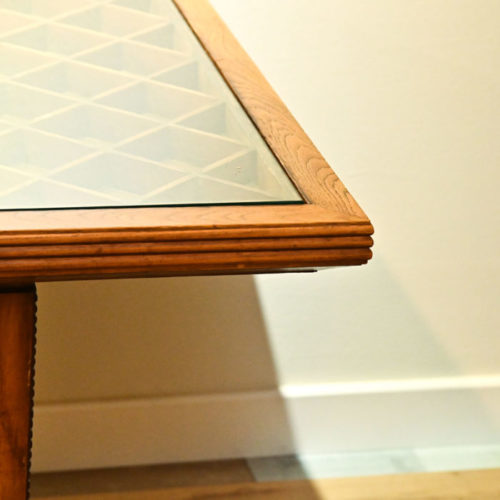 1940's table in chestnut and glass top, with particular cross work. In excellent condition. Period: 1940s Measurements: H 78 x W 189.5 x D 94.5 cm
1940's table in chestnut and glass top, with particular cross work. In excellent condition. Period: 1940s Measurements: H 78 x W 189.5 x D 94.5 cm -
Out of stock
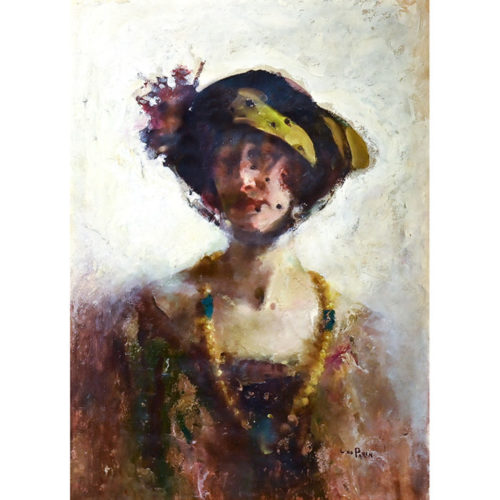 "Woman with veil" oil on paper by Gino Parin. The painting is from the 20s / 30s of the twentieth century, has a beautiful coeval gilded wood frame. The picture and the frame need some cleaning. It comes from a private collection from Biella. Gino Parin was born in Trieste in 1876. His real name was Federico Gino Pollack. He began his artistic education in the studio of the Trieste painter Eugenio Scomparini and then continued at the Venetian Girolamo Navarra's one. At 19 he went to Munich to attend the Academy where he attended the courses of Karl Raupp and became acquainted with the painting of the Pre-Raphaelites, Lenbach, von Marées and von Stuck. Having become a member of the Münchener Künstler Genossenschaft, he often exhibited at the Glaspalast. He traveled extensively in Europe, visiting Switzerland, France and England. From 1910 he began to participate in the collective exhibitions of the Trieste Artistic Circle. Here he settled permanently at the outbreak of the First World War. He participated to the Biennials of 1921, 1924, 1928 and 1932. In 1923 he received the gold medal at the Turin Quadrennial. During this period his style, from the original German academic setting, evolved towards a personal reworking of the taste of the Deco years. His production, mainly focused on female portraits and interior painting, earned him the definition of "painter of beautiful women". Deported by the Germans in 1944, he died in the Bergen Belsen camp. Period: 1920s / 30s Measurements: In frame H 102 x W 82 x D 7.5 / Canvas H 79 x W 59 cm
"Woman with veil" oil on paper by Gino Parin. The painting is from the 20s / 30s of the twentieth century, has a beautiful coeval gilded wood frame. The picture and the frame need some cleaning. It comes from a private collection from Biella. Gino Parin was born in Trieste in 1876. His real name was Federico Gino Pollack. He began his artistic education in the studio of the Trieste painter Eugenio Scomparini and then continued at the Venetian Girolamo Navarra's one. At 19 he went to Munich to attend the Academy where he attended the courses of Karl Raupp and became acquainted with the painting of the Pre-Raphaelites, Lenbach, von Marées and von Stuck. Having become a member of the Münchener Künstler Genossenschaft, he often exhibited at the Glaspalast. He traveled extensively in Europe, visiting Switzerland, France and England. From 1910 he began to participate in the collective exhibitions of the Trieste Artistic Circle. Here he settled permanently at the outbreak of the First World War. He participated to the Biennials of 1921, 1924, 1928 and 1932. In 1923 he received the gold medal at the Turin Quadrennial. During this period his style, from the original German academic setting, evolved towards a personal reworking of the taste of the Deco years. His production, mainly focused on female portraits and interior painting, earned him the definition of "painter of beautiful women". Deported by the Germans in 1944, he died in the Bergen Belsen camp. Period: 1920s / 30s Measurements: In frame H 102 x W 82 x D 7.5 / Canvas H 79 x W 59 cm -
Out of stock
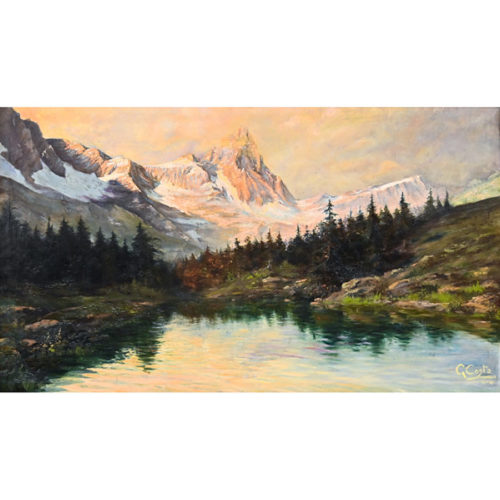 "The Matterhorn with the blue lake" oil on canvas from the early 1920s by Giovanni Battista Costa (Rapallo 1858 - Genoa 1838). The painting has been restored. Giovanni Battista Costa was born in Rapallo in 1858 in a wealthy family and dedicated his entire life to art. He participated, since 1879, in the exhibitions of the Promoting Society of Fine Arts in Genoa and in numerous other important Italian expositions, exhibiting, until 1921, over 100 paintings, mainly landscapes, seascapes and portraits. In 1895 he was appointed Academic of Merit of Ligustica, where he, too, teached. He began his artistic studies at the Ligustica Academy (and partly in Rome), soon going from a painting linked to tradition to the execution of works from life, probably under the guidance of Tammar Luxoro director, from 1874, of the new Landscape School. Consequently, the links with the Genoese Gray School, the Rivara School (in Piedmont) and the Tuscan Macchiaiolo movement appear to be close. The analysis of some of his works lead us to bring Costa closer to some Lombard painters of the 19th century: for example Carcano, especially for the softness of the colours. He takes part in numerous national exhibitions: awarded in 1897 in Venice, he participates in the National Exhibition of Fine Arts in Turin in 1898; in 1906 we find it at the National Exhibition of Fine Arts in Milan; also worth mentioning is his participation in the first Quadrennial Exhibition in Turin in 1902. Giovanni Battista Costa was also a skilled portrait painter and painted in Venice, Parma, Viareggio, Ivrea, Engadina, Valle d’Aosta. Even though he was shy and solitary, he was part of two important schools: the Ligurian Artistic Family (1893 -1910 circa) and the Teatro Group (from 1908); refers to the upper room of the Caffè degli Amici of the Carlo Felice Theater. He is an artist particularly attentive to the social problems of the late nineteenth century. His works appear, in retrospect, in Genoa at the exhibition of Ligurian Painters of the Nineteenth Century (Palazzo Rosso, 1938) and at the Commemorative Exhibition at the San Matteo Gallery, 1952. In his maturity he turned his interest to the representation of mountain landscapes. In conclusion, we can identify three different ways of painting by Costa: the first is related to academic painting, a bit rigid (church interiors and portraiture); the second, realist, with warm colours and close to the themes of the Grays and Rivarians (affinity with Benedetto Musso). Period: 1920s Measurements: In frame H 125 x W 195 x D 6 / Canvas H 101 x W 172 cm
"The Matterhorn with the blue lake" oil on canvas from the early 1920s by Giovanni Battista Costa (Rapallo 1858 - Genoa 1838). The painting has been restored. Giovanni Battista Costa was born in Rapallo in 1858 in a wealthy family and dedicated his entire life to art. He participated, since 1879, in the exhibitions of the Promoting Society of Fine Arts in Genoa and in numerous other important Italian expositions, exhibiting, until 1921, over 100 paintings, mainly landscapes, seascapes and portraits. In 1895 he was appointed Academic of Merit of Ligustica, where he, too, teached. He began his artistic studies at the Ligustica Academy (and partly in Rome), soon going from a painting linked to tradition to the execution of works from life, probably under the guidance of Tammar Luxoro director, from 1874, of the new Landscape School. Consequently, the links with the Genoese Gray School, the Rivara School (in Piedmont) and the Tuscan Macchiaiolo movement appear to be close. The analysis of some of his works lead us to bring Costa closer to some Lombard painters of the 19th century: for example Carcano, especially for the softness of the colours. He takes part in numerous national exhibitions: awarded in 1897 in Venice, he participates in the National Exhibition of Fine Arts in Turin in 1898; in 1906 we find it at the National Exhibition of Fine Arts in Milan; also worth mentioning is his participation in the first Quadrennial Exhibition in Turin in 1902. Giovanni Battista Costa was also a skilled portrait painter and painted in Venice, Parma, Viareggio, Ivrea, Engadina, Valle d’Aosta. Even though he was shy and solitary, he was part of two important schools: the Ligurian Artistic Family (1893 -1910 circa) and the Teatro Group (from 1908); refers to the upper room of the Caffè degli Amici of the Carlo Felice Theater. He is an artist particularly attentive to the social problems of the late nineteenth century. His works appear, in retrospect, in Genoa at the exhibition of Ligurian Painters of the Nineteenth Century (Palazzo Rosso, 1938) and at the Commemorative Exhibition at the San Matteo Gallery, 1952. In his maturity he turned his interest to the representation of mountain landscapes. In conclusion, we can identify three different ways of painting by Costa: the first is related to academic painting, a bit rigid (church interiors and portraiture); the second, realist, with warm colours and close to the themes of the Grays and Rivarians (affinity with Benedetto Musso). Period: 1920s Measurements: In frame H 125 x W 195 x D 6 / Canvas H 101 x W 172 cm -
Out of stock
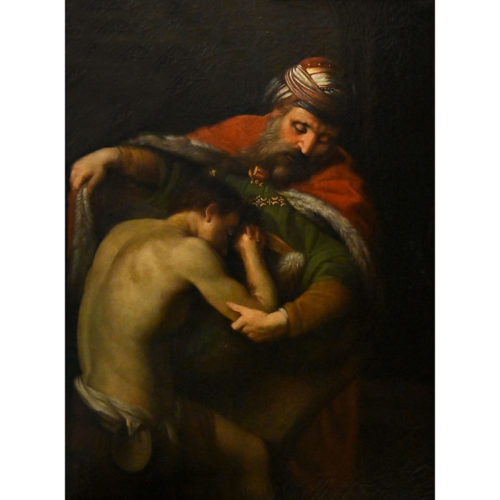
"The return of the prodigal son" oil on canvas from the second half of the 19th century. With coeval wooden frame and gilded leaf tablet. The work is in fair condition, to be restored.
Copy of "The Return of the Prodigal Son" by Pompeo Batoni, 1773, is now conserved at the Kunsthistorisches Museum, Vienna.
The parable of the prodigal son (Luke 15: 11-32) tells of the forgiveness of a father who welcomes his younger son, after he had squandered his part of his inheritance.Period: Second half of the 19th century
Measurements: In frame H 155 x W 118 x D 3 / Canvas H 135 x W 99 cm
-
Out of stock
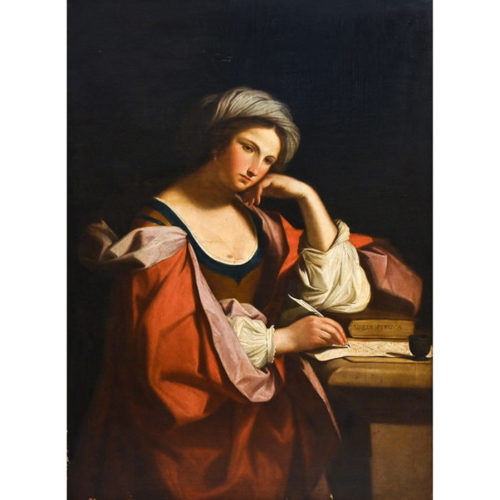 "Sibilla Persica" oil on canvas, a work made between the eighteenth and early nineteenth century. Large painting, of excellent quality, depicting the Persian Sibyl. Coeval frame, re-painted, the surface has no previous restorations, apart from small touches to be done, it is in excellent condition. The painting is a copy of the "Persian Sibyl" of 1647, preserved in the Capitoline Museums, in Rome, by Giovanni Francesco Barbieri, known as Guercino (1591-1666), one of the most important Italian painters of the 17th century. The Sibyl is a mythological figure present in both Greek and Roman culture. The classical tradition tells us that she was dealing with virgin women endowed with prophetic virtues, derived from the intercession of a divinity (which was usually Apollo); they were therefore able to provide responses or make predictions and were worshiped for this. The first historical reference to the Sibyls is found among the works of Plato where, however, he indicates only one. Varrone will be the first to provide a real list of these mythological figures among which the Persian Sibyl will also appear, the subject of this portrait, counted among the oldest. The classical tradition divided them into groups, based on their geographical origin: oriental, Greek-Ionic and Greek-Italic; the Persian Sibyl (or Persian) belonged to the eastern group. Period: Between the 18th and early 19th centuries Measurements: In frame H 145 x W 109 x D 4 / Canvas H 135 x L 98.5 cm
"Sibilla Persica" oil on canvas, a work made between the eighteenth and early nineteenth century. Large painting, of excellent quality, depicting the Persian Sibyl. Coeval frame, re-painted, the surface has no previous restorations, apart from small touches to be done, it is in excellent condition. The painting is a copy of the "Persian Sibyl" of 1647, preserved in the Capitoline Museums, in Rome, by Giovanni Francesco Barbieri, known as Guercino (1591-1666), one of the most important Italian painters of the 17th century. The Sibyl is a mythological figure present in both Greek and Roman culture. The classical tradition tells us that she was dealing with virgin women endowed with prophetic virtues, derived from the intercession of a divinity (which was usually Apollo); they were therefore able to provide responses or make predictions and were worshiped for this. The first historical reference to the Sibyls is found among the works of Plato where, however, he indicates only one. Varrone will be the first to provide a real list of these mythological figures among which the Persian Sibyl will also appear, the subject of this portrait, counted among the oldest. The classical tradition divided them into groups, based on their geographical origin: oriental, Greek-Ionic and Greek-Italic; the Persian Sibyl (or Persian) belonged to the eastern group. Period: Between the 18th and early 19th centuries Measurements: In frame H 145 x W 109 x D 4 / Canvas H 135 x L 98.5 cm -
Out of stock
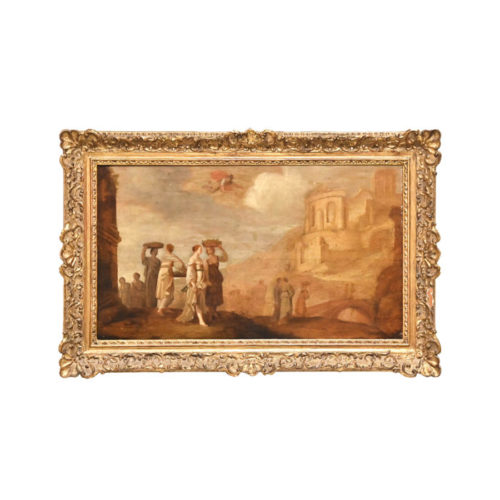 Neoclassical painting, oil on original late 18th century panel, with carved and gilded frame. Period: End of the 18th century Measurements: In frame H 55 x W 84 x D 6 / Table H 39 x L 68 cm
Neoclassical painting, oil on original late 18th century panel, with carved and gilded frame. Period: End of the 18th century Measurements: In frame H 55 x W 84 x D 6 / Table H 39 x L 68 cm -
Out of stock
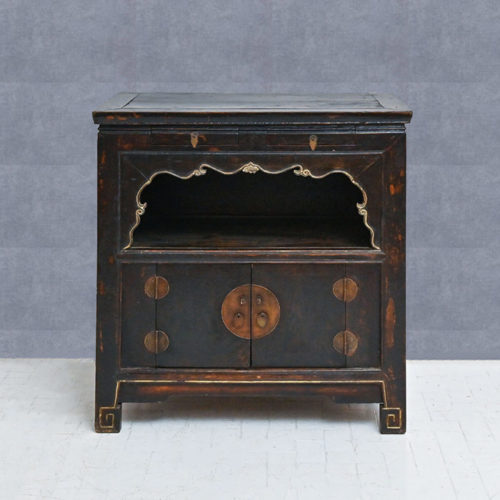 Chinese lacquered cabinet from the 20th century. Furniture made of carved and black lacquered wood, with 2 doors and a day compartment. In excellent condition. Period: 20th century Measurements: H 95.5 x W 88.5 x D 59 cm
Chinese lacquered cabinet from the 20th century. Furniture made of carved and black lacquered wood, with 2 doors and a day compartment. In excellent condition. Period: 20th century Measurements: H 95.5 x W 88.5 x D 59 cm -
Out of stock
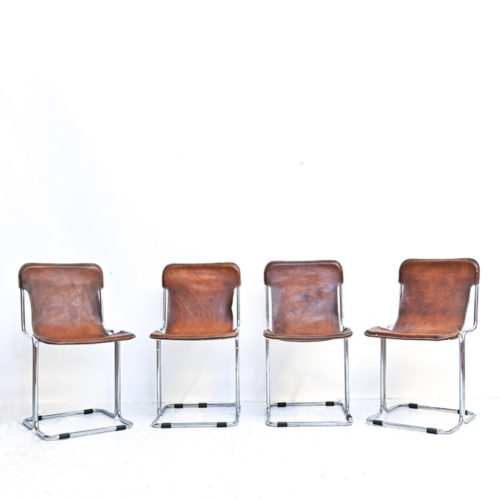 Group of 4 chairs by Antonio Ari Colombo in chromed iron and leather from the 1960s. The leather is in excellent condition, structures to be polished, two screws are missing. Period: 1960s Measurements: H 81 x W 44 x D 50 cm / H seat 46 cm
Group of 4 chairs by Antonio Ari Colombo in chromed iron and leather from the 1960s. The leather is in excellent condition, structures to be polished, two screws are missing. Period: 1960s Measurements: H 81 x W 44 x D 50 cm / H seat 46 cm -
Out of stock
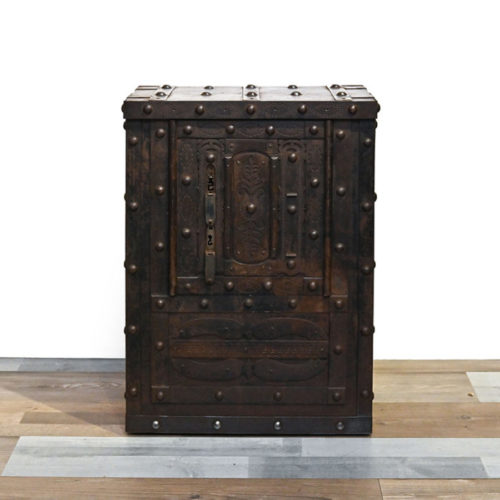 Piedmontese safe from the mid-19th century fully studded, with double lock. Inside there are two wooden drawers. In good condition. Period: Mid 19th century Measurements: H 76 x W 55.5 x D 32 cm
Piedmontese safe from the mid-19th century fully studded, with double lock. Inside there are two wooden drawers. In good condition. Period: Mid 19th century Measurements: H 76 x W 55.5 x D 32 cm -
Out of stock
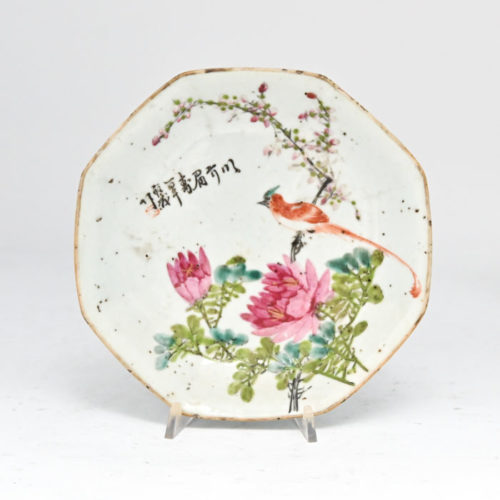 One of six antique ceramic saucers / backsplashes, China, from the early 1900s. Period: Early 1900s Measurements: H 19.5 x W 20 x D 4.5 cm
One of six antique ceramic saucers / backsplashes, China, from the early 1900s. Period: Early 1900s Measurements: H 19.5 x W 20 x D 4.5 cm -
Out of stock
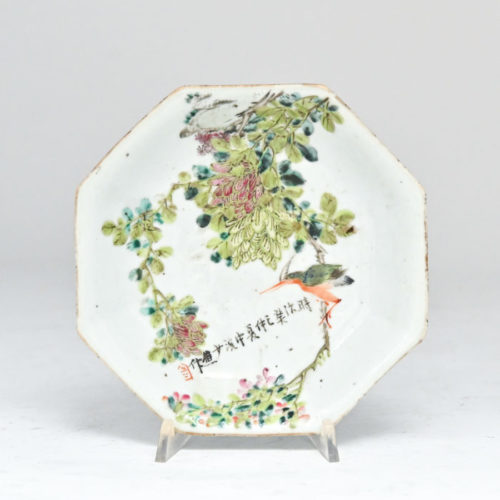 One of six antique ceramic saucers / backsplashes, China, from the early 1900s. Period: Early 1900s Measurements: H 16 x W 16 x D 4.5 cm
One of six antique ceramic saucers / backsplashes, China, from the early 1900s. Period: Early 1900s Measurements: H 16 x W 16 x D 4.5 cm -
Out of stock
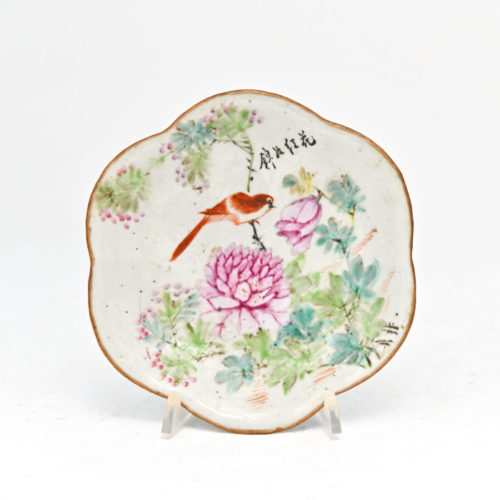 One of six antique ceramic saucers / backsplashes, China, from the early 1900s. Period: Early 1900s Measurements: H 15 x W 16.5 x D 4 cm
One of six antique ceramic saucers / backsplashes, China, from the early 1900s. Period: Early 1900s Measurements: H 15 x W 16.5 x D 4 cm -
Out of stock
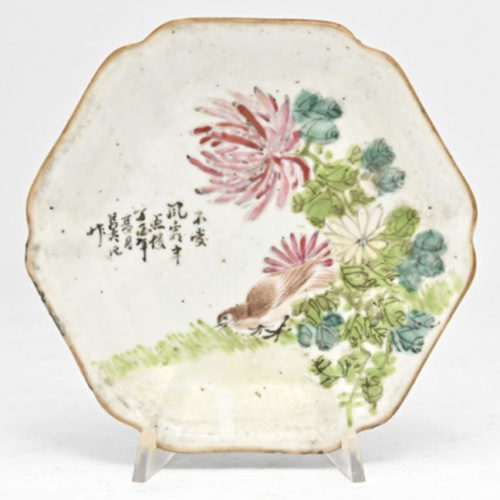 One of six antique ceramic saucers / backsplashes, China, from the early 1900s. Period: Early 1900s Measurements: H 15.5 x W 16.5 x D 4 cm
One of six antique ceramic saucers / backsplashes, China, from the early 1900s. Period: Early 1900s Measurements: H 15.5 x W 16.5 x D 4 cm -
Out of stock
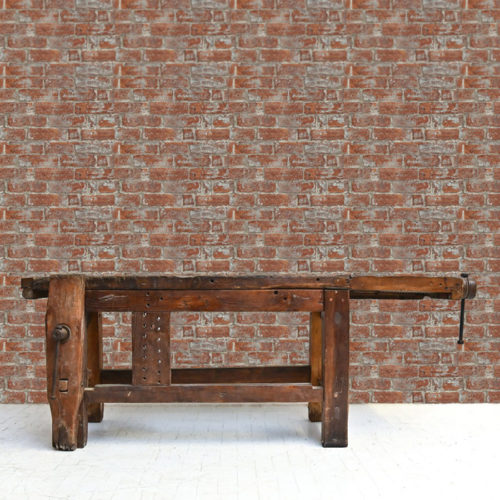 Carpenter's bench from the end of the 19th century, in larch, with double vice. Period: End of the 19th century Measurements: Flat net L 209 x H 81 x P 70 / With clamps L 217 x H 81 x P 83 cm
Carpenter's bench from the end of the 19th century, in larch, with double vice. Period: End of the 19th century Measurements: Flat net L 209 x H 81 x P 70 / With clamps L 217 x H 81 x P 83 cm -
Out of stock
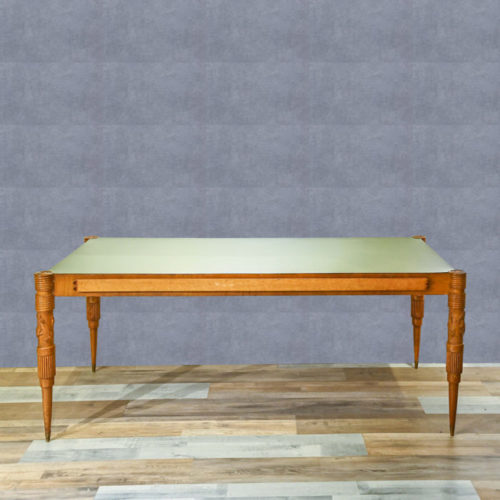 Pier Luigi Colli (1895-1968), table from the 1950s. The table has elegant cylindrical carved legs, it was built in elm, briar and brass; the top is in green formica. The cabinet is in excellent condition. Period: 1950s Measurements: H 77 x W 180 x D 86.5 cm
Pier Luigi Colli (1895-1968), table from the 1950s. The table has elegant cylindrical carved legs, it was built in elm, briar and brass; the top is in green formica. The cabinet is in excellent condition. Period: 1950s Measurements: H 77 x W 180 x D 86.5 cm -
Out of stock
 Original antique 17th-century Piedmontese frame in ebonized wood and gold. Period: '600 Measurements: H 99.5 x W 123 x D 7 / Internal light H 74 x W 92.5 cm
Original antique 17th-century Piedmontese frame in ebonized wood and gold. Period: '600 Measurements: H 99.5 x W 123 x D 7 / Internal light H 74 x W 92.5 cm -
Out of stock
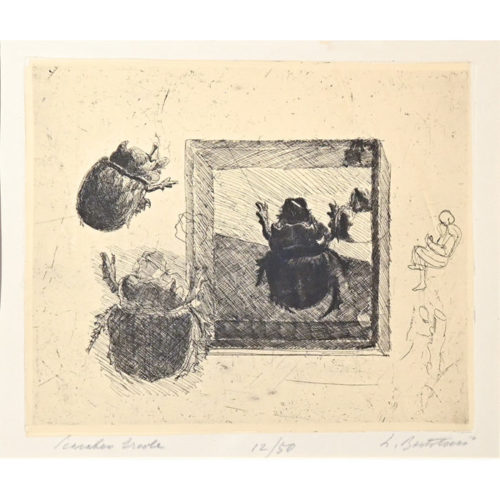 "Scarabeo Ercole" etching by Luigi Bartolini. The sheet is H 235 x L 285 mm. The title is written in pencil at the bottom left. Edition in pencil at the lower center, it is 12 out of 50 copies. The signature in pencil is Luigi Bartolini on the lower right. It is displayed at the National Institute of Graphics, Prints and Drawings Department, in Rome. Luigi Bartolini (Cupramontana 1892 - Rome 1963), spent his youth among Rome, Siena and Florence, attending Academies of Fine Arts and staying for a long time in Galleries, Museums and Libraries. In 1914 he began to engrave in etching, in which he gained wide fame. Writer, painter and heated polemicist, poet, exuberant critic, he had conflicts that remained famous. In 1932 he won the highest prize shared with Morandi and Boccioni at the engraving exhibition in Florence. In 1935 he earned the Rome Quadrennial Award for the best etching artwork. In 1942 he obtained the prize at the Venice Biennale for his black and white technique. His paintings with large and sumptuous brushstrokes of color, of a lively immediacy, brought him to the fore among the most renowned artists. Period: 1934 Measurements: In frame H 53.5 x W 63 x D 1 / Plate H 23.5 x W 28.5 cm
"Scarabeo Ercole" etching by Luigi Bartolini. The sheet is H 235 x L 285 mm. The title is written in pencil at the bottom left. Edition in pencil at the lower center, it is 12 out of 50 copies. The signature in pencil is Luigi Bartolini on the lower right. It is displayed at the National Institute of Graphics, Prints and Drawings Department, in Rome. Luigi Bartolini (Cupramontana 1892 - Rome 1963), spent his youth among Rome, Siena and Florence, attending Academies of Fine Arts and staying for a long time in Galleries, Museums and Libraries. In 1914 he began to engrave in etching, in which he gained wide fame. Writer, painter and heated polemicist, poet, exuberant critic, he had conflicts that remained famous. In 1932 he won the highest prize shared with Morandi and Boccioni at the engraving exhibition in Florence. In 1935 he earned the Rome Quadrennial Award for the best etching artwork. In 1942 he obtained the prize at the Venice Biennale for his black and white technique. His paintings with large and sumptuous brushstrokes of color, of a lively immediacy, brought him to the fore among the most renowned artists. Period: 1934 Measurements: In frame H 53.5 x W 63 x D 1 / Plate H 23.5 x W 28.5 cm -
Out of stock
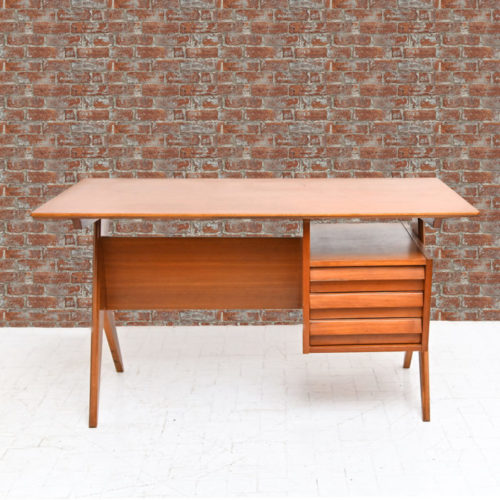 Writing desk, from the 1950s, desk in mahogany. In very good condition, small lack of veneer on one drawer. Period: 1950s Measurements: H 75 x W 117 x D 68 cm
Writing desk, from the 1950s, desk in mahogany. In very good condition, small lack of veneer on one drawer. Period: 1950s Measurements: H 75 x W 117 x D 68 cm -
Out of stock
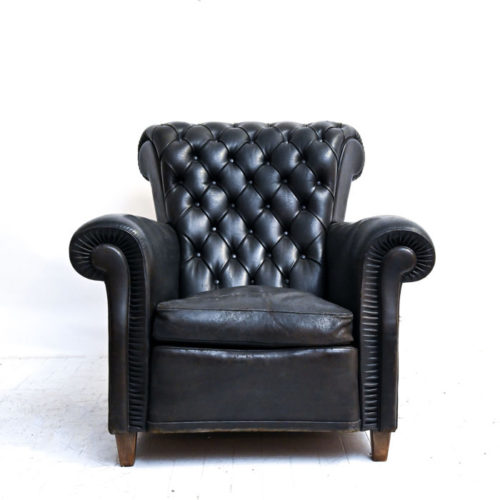 Antique original Poltrona Frau from the early 1900s, in good condition. Period: Early 20th century Measurements: H 90 x W 80 x D 105.5 cm
Antique original Poltrona Frau from the early 1900s, in good condition. Period: Early 20th century Measurements: H 90 x W 80 x D 105.5 cm -
Out of stock
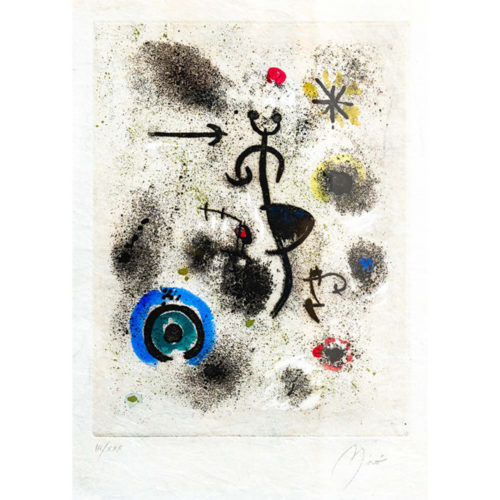 Original lithograph (III / XXX) by Joan Mirò (1893-1983). Edition of 30 copies, Roman numerals, this is 3rd out of 30. Signed on the lower right. Period: Twentieth century Measurements: Print H 38.5 x L 29.5 / Paper H 66 x L 50 cm
Original lithograph (III / XXX) by Joan Mirò (1893-1983). Edition of 30 copies, Roman numerals, this is 3rd out of 30. Signed on the lower right. Period: Twentieth century Measurements: Print H 38.5 x L 29.5 / Paper H 66 x L 50 cm -
Out of stock
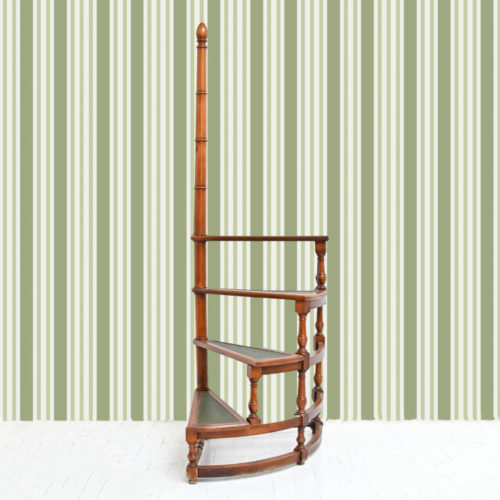 English ladder in beech, upright pillars in turned wood, 4 steps with green leather upholstery. Very good condition. Period: 1940 Measurements: H 172 x W 57 x D 57 cm
English ladder in beech, upright pillars in turned wood, 4 steps with green leather upholstery. Very good condition. Period: 1940 Measurements: H 172 x W 57 x D 57 cm -
Out of stock
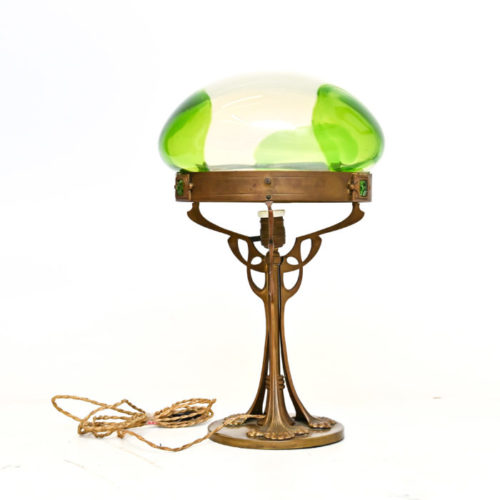 Art Nouveau lamp in the Johann Loetz style (1880-1940), dichrome glass with slight gilding, brass base. Period: 1880/1910 Measurements: H 52 x D 101 cm
Art Nouveau lamp in the Johann Loetz style (1880-1940), dichrome glass with slight gilding, brass base. Period: 1880/1910 Measurements: H 52 x D 101 cm -
Out of stock
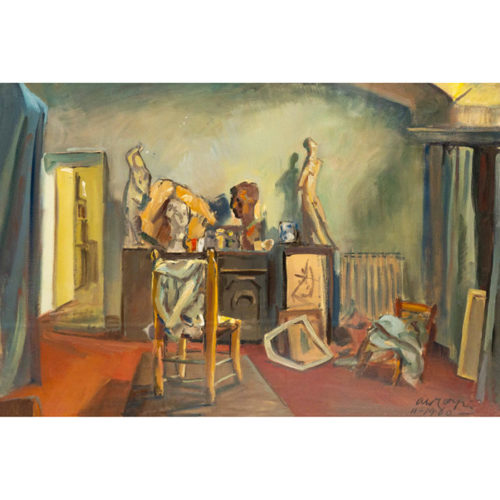 "Interior studio", painting by Aldo Carpi de 'Resmini (Milan, 6 October 1886 - Milan, 27 March 1973), oil on canvas signed and dated 11 - 19 - 1960 on the lower right. Aldo Carpi, the famous Italian painter, has a very peculiar history, in fact he was deported to Gusen, a satellite camp in Mauthausen, Austria, where only 2 percent of the prisoners managed to survive. He was saved thanks to his talent and was the author - at the risk of his life - of the only real "live" diary inside an extermination camp. A vertical man, a Righteous who has known and suffered the most atrocious sufferings, but who has never bent to "recognize the active presence of" evil "in the hearts of his fellow men", as the famous art critic Mario De wrote Micheli. Period: 1960s Measurements: In frame H 89 x W 119 x D 5 Canvas H 60 x W 90 cm
"Interior studio", painting by Aldo Carpi de 'Resmini (Milan, 6 October 1886 - Milan, 27 March 1973), oil on canvas signed and dated 11 - 19 - 1960 on the lower right. Aldo Carpi, the famous Italian painter, has a very peculiar history, in fact he was deported to Gusen, a satellite camp in Mauthausen, Austria, where only 2 percent of the prisoners managed to survive. He was saved thanks to his talent and was the author - at the risk of his life - of the only real "live" diary inside an extermination camp. A vertical man, a Righteous who has known and suffered the most atrocious sufferings, but who has never bent to "recognize the active presence of" evil "in the hearts of his fellow men", as the famous art critic Mario De wrote Micheli. Period: 1960s Measurements: In frame H 89 x W 119 x D 5 Canvas H 60 x W 90 cm -
Out of stock
 Coffee table in slate and scagliola with plexiglass base. The top dates back to the 19th century, by a Florentine workshop, decorated with a map of the constellations of Guiljelmus BLAEU (1600-1699), on the edge the signs of the zodiac. In the 70s / 80s it was combined with the plexiglass base to form a coffee table with glass of rare beauty. Period: between the 18th and 19th centuries Measurements: H 43 x W 138 x D 54,5
Coffee table in slate and scagliola with plexiglass base. The top dates back to the 19th century, by a Florentine workshop, decorated with a map of the constellations of Guiljelmus BLAEU (1600-1699), on the edge the signs of the zodiac. In the 70s / 80s it was combined with the plexiglass base to form a coffee table with glass of rare beauty. Period: between the 18th and 19th centuries Measurements: H 43 x W 138 x D 54,5 -
Out of stock
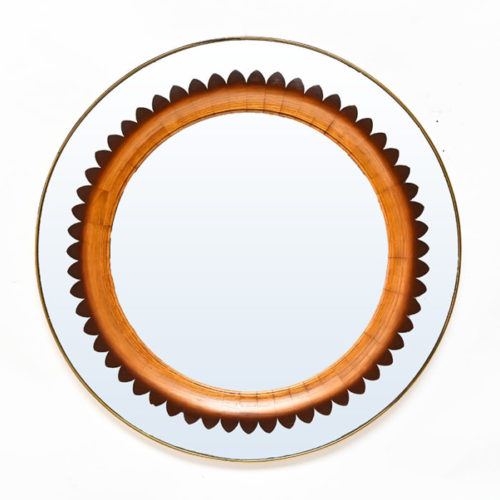 Rare mirror by Pier Luigi Colli for Marelli from the 1950s, in elm wood, antique mirror and brass finishes, original and in excellent condition. Period: 1950s Measurements: Ø 100 x D 5
Rare mirror by Pier Luigi Colli for Marelli from the 1950s, in elm wood, antique mirror and brass finishes, original and in excellent condition. Period: 1950s Measurements: Ø 100 x D 5 -
Out of stock
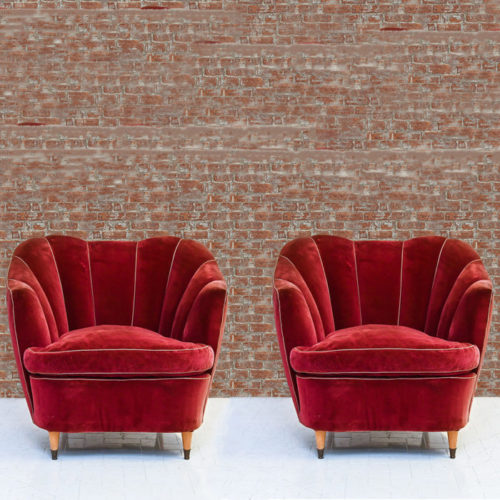 Pair of original crimson velvet armchairs. 1950s style by Gio Ponti. Backrest with shell shape, truncated conical feet with brass ends. In good condition, the matching sofa is also for sale. Period: 1950 Measurements: H 82 L 90 P 88 (H seat 50) cm
Pair of original crimson velvet armchairs. 1950s style by Gio Ponti. Backrest with shell shape, truncated conical feet with brass ends. In good condition, the matching sofa is also for sale. Period: 1950 Measurements: H 82 L 90 P 88 (H seat 50) cm -
Out of stock
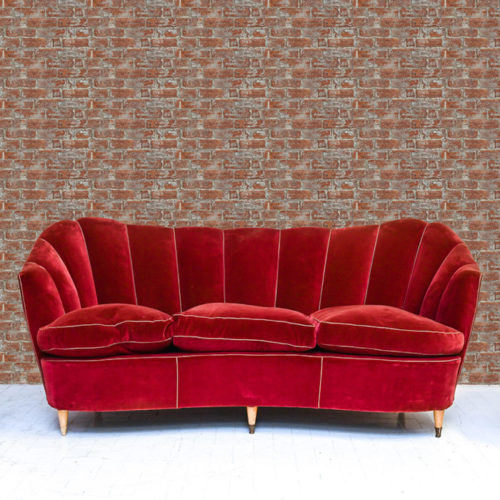 Gio Ponti style sofa in the original crimson velvet. Backrest with shell shape, 6 truncated conical feet with brass ends. In good condition, also the pair of matching armchairs for sale. Period: 1950 Measurements: H 82 L 186 D 88 (H seat 50) cm
Gio Ponti style sofa in the original crimson velvet. Backrest with shell shape, 6 truncated conical feet with brass ends. In good condition, also the pair of matching armchairs for sale. Period: 1950 Measurements: H 82 L 186 D 88 (H seat 50) cm -
Out of stock
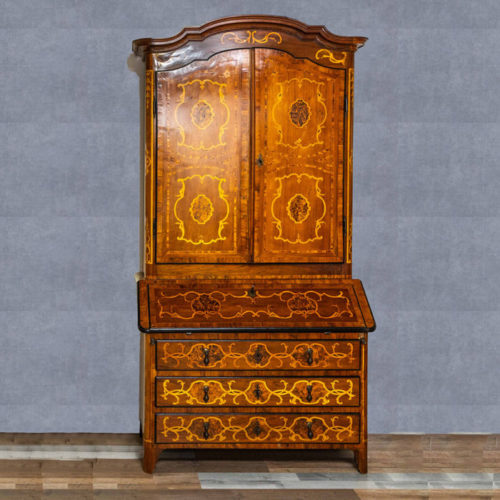 Mid-eighteenth-century Louis XV Piedmontese trumeau, in walnut with maple scrollwork inlays. Excellent condition, some inlays have been replaced with rice paste. Period: Half 700 Measurements: H 250 x W 131 x D 61.5 cm
Mid-eighteenth-century Louis XV Piedmontese trumeau, in walnut with maple scrollwork inlays. Excellent condition, some inlays have been replaced with rice paste. Period: Half 700 Measurements: H 250 x W 131 x D 61.5 cm -
Out of stock
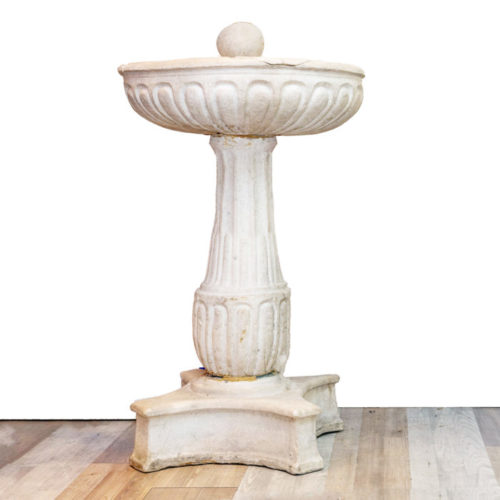 Ancient stoup in carved white marble, 17th century in good condition. Period: '600 Measurements: H 130 x D 64 cm
Ancient stoup in carved white marble, 17th century in good condition. Period: '600 Measurements: H 130 x D 64 cm